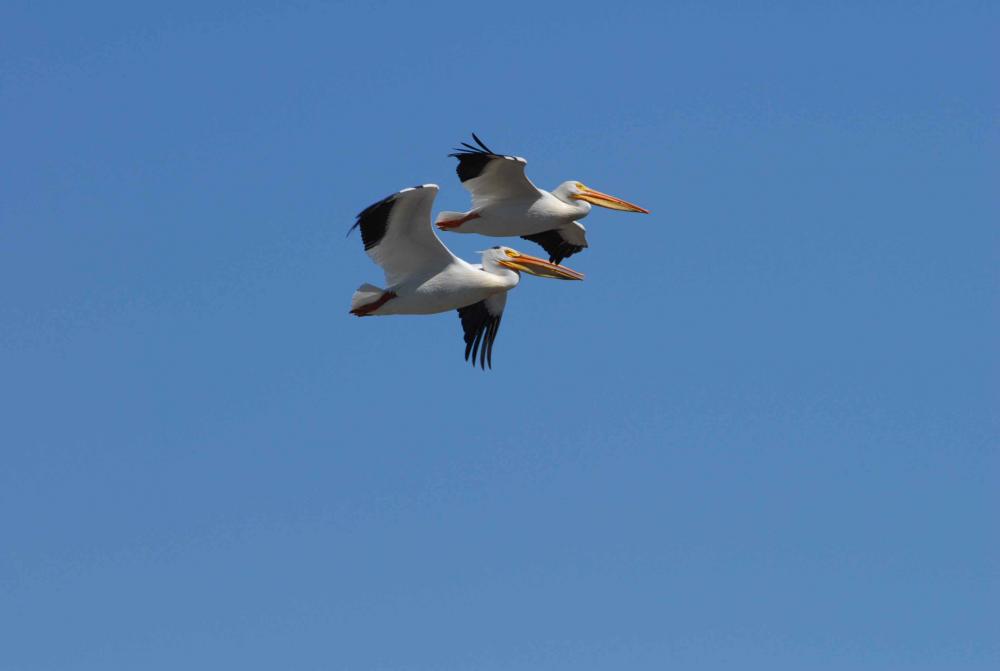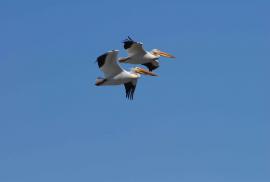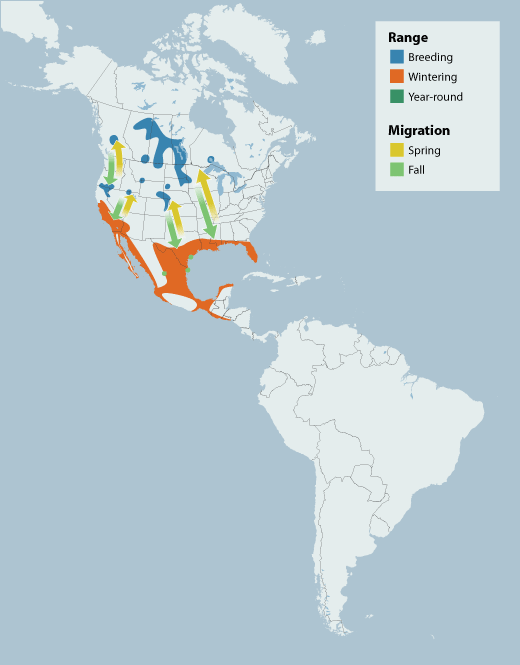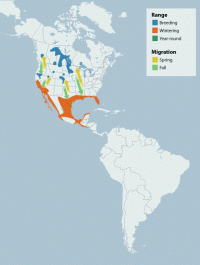Guide to Boreal Birds
This is an in-depth boreal species profile.
What is this?
This species is one of more than 30 birds selected for in-depth profiles. Find out why and see all selected boreal birds »
Overview
American White Pelicans are gregarious birds, often associated with Double-crested Cormorants. Few can fail to be impressed by the sight of this spectacular species, one of the largest boreal birds, soaring overhead or feeding in synchronized groups. A flock of migrating American White Pelicans is a majestic sight-a long line of ponderous birds, flapping and coasting. Each bird seems to take its cue from the one in front of it, beginning to flap and starting a glide when its predecessor does. These birds ride rising air currents to great heights, where they soar slowly and gracefully in circles. These birds are more buoyant than Brown Pelicans and do not dive for their food. They cooperate to surround fish in shallow water, scooping them into their pouches. They take in both water and fish, and then hold their bills vertically to drain out the water before swallowing the food. This species is something of a conservation success story, with major population declines and range contractions before 1980 largely reversed.
Description
55-70" (1.4-1.8 m). W. 8' (2.4 m). A huge white bird with a long flat bill and black wing tips. In breeding season, has short yellowish crest on back of head and horny plate on upper mandible. Young birds duskier than adults.
Voice
Usually silent; grunts or croaks on nesting grounds.
Nesting
1-6 whitish eggs on a low mound of earth and debris on a marshy island; occasionally on rocky islands in desert lakes. Nests in colonies.
Habitat
The American White Pelican is dependent on wetlands for its survival, and the boreal forest provides plenty. It nests on islands in freshwater and saline lakes, foraging in shallow waters up to 50 kilometers (30 miles) or more away. It uses similar foraging sites during migration to its largely coastal wintering sites. Preferred winter habitats are shallow bays, inlets, and estuaries containing suitable prey and loafing sites; it also can be seen on man-made ponds and lagoons.
Range/Migration
American White Pelicans segregate well into two separate geographic groups. Populations breeding east of the Rocky Mountains migrate south and east, mostly along river valleys, to winter along the Gulf of Mexico. Populations west of the Rockies migrate over deserts and mountains to the Pacific coast. Migration occurs mainly during daylight in flocks sometimes numbering in the hundreds, often flying in the familiar V-formation and using thermals when available. Fall migration is protracted, with individuals lingering on southerly breeding grounds as late as December in mild winters. Spring arrival on breeding grounds is as early as February in Nevada, March in Utah, and April in Wyoming and Manitoba, usually before lakes but after rivers have thawed, providing some foraging sites even if nest sites are inaccessible. Large numbers of migrating pelicans can be seen in fall at Horicon National Wildlife Refuge in Wisconsin; in spring at Deer Flat National Wildlife Refuge in Idaho; and in both seasons at Cheyenne Bottoms Wildlife Area in Kansas and Sand Lake National Wildlife Refuge in South Dakota.
Breeding
The American White Pelican breeds in a dozen or so disjunct areas. The largest of these extends from the southern fringes of the boreal forest in the Canadian prairie provinces south through the prairies and high plains to Montana and South Dakota. Other populations are scattered through the Great Basin, Intermountain, and Plains regions from British Columbia and Ontario to California and Colorado. Non-migratory populations occur in Texas and Mexico. This species is seasonally monogamous, pairing quickly after arrival at breeding sites. Courtship consists of circular flights over the nesting site, often with other individuals, and a variety of displays on the ground, including strutting, bowing, and head swaying. Sub-colonies form and grow as individuals are attracted and stimulated by the breeding activities of their neighbors. The nest is merely a shallow depression, the rim often barely sufficient to keep eggs and chicks from rolling out. Two eggs are laid; incubation is by both parents equally, in two-day shifts, and lasts about 30 days. The young are born naked and blind, but their eyes open within a day. Parents regurgitate food for the young, onto the ground or their feet at first; thereafter the parents regurgitate the food to their own bill tip, then only within their pouch, and finally only into their own throat, whence the young remove it. The first-hatched chick usually harasses its younger sibling until the latter dies of starvation. The parents alternate between brooding and foraging, switching daily, for about 17 to 25 days, after which the surviving young begin leaving the nests and forming creches while both parents forage. Initially, the young return to their nests from the creches to eat and to be brooded at night, but as they get older they become less attached to the nest. The young take their first flights at about 9 to 10 weeks of age and leave the colony soon thereafter.
Diet/Feeding Behavior
Like all pelicans, the American White Pelican is primarily a fish eater. Its usual prey species are small schooling fish, but it also eats some bottom feeders; within the preferred size range, it is non-selective, taking prey purely on the basis of availability. It also takes salamanders and crayfish opportunistically. The species often uses a characteristic group feeding strategy wherein a flock will form a circle or semi-circle and, using coordinated bill dipping and wing beating, drive prey toward shore where it is more easily caught. It also forages individually but with lower success; foraging behavior tends to shift toward cooperation when prey aggregations are located. It commonly forages at night during the breeding season, using tactile means of locating prey; daytime foraging is probably more visual. This species never plunge-dives like the Brown Pelican (Pelecanus occidentalis). Daily food intake of breeding adults may reach 40 percent of body mass. White Pelicans often steal prey from one another and from other species, especially diving birds in deeper waters.
References
Evans, R. M., and K. J. Cash. 1985. Early spring flights of American White Pelicans: Timing and functional role in attracting others to the breeding colony. Condor 87:252-255.
Evans, R. M., and F. L. Knopf. 1993. American White Pelican (Pelecanus erythrorhynchos). In The Birds of North America, No. 57 (A. Poole and F. Gill, Eds.). Philadelphia: The Academy of Natural Sciences; Washington, D.C.: The American Ornithologists' Union.
Evans, R. M., and B. F. McMahon. 1987. Within-brood variation in growth and condition in relation to brood reduction in the American White Pelican. Wilson Bull. 99:190-201.
Knopf, F. L. 1979. Spatial and temporal aspects of colonial nesting of White Pelicans. Condor 81:353-363.
National Audubon Society. 2002. The Christmas Bird Count Historical Results [Online]. http://www.audubon.org/bird/cbc.
Sauer, J. R., J. E. Hines, and J. Fallon. 2003. The North American Breeding Bird Survey, Results and Analysis 1966-2002, Version 2003.1, USGS Patuxent Wildlife Research Center, Laurel, MD.
Sidle, J. G., W. H. Koonz, and K. Roney. 1985. Status of the American White Pelican: an update. Amer. Birds 39:859-864.
Credits
Birding content provided by National Wildlife Federation/eNature, with support from Ducks Unlimited/The Pew Charitable Trusts.





